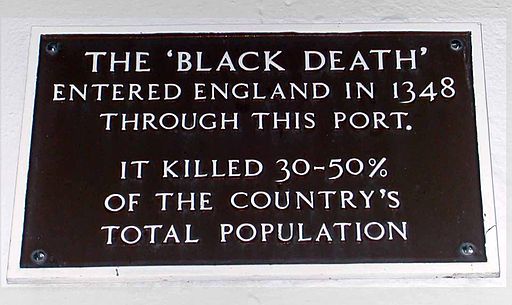
The Black Death
“Ring-a-ring-a-roses, a pocket full of posies. A-tishoo, a-tishoo, we all fall down.”
Since the dawn of man, the human race has been threatened with extinction many times. The present pandemic of the Zika virus is only the latest threat to human populations. In the early 14th Century, such an extinction came dangerously close to occurring. It was during this time, from 1346 – 53, that bubonic plague killed some 50% of the world’s known population. In one year alone (1347), 60 -80% of the inhabitants of Florence and Sienna died of the disease.
Previously it had been thought that bubonic plague originated in China and spread along the Silk Road. Now, though, the belief is that it originated in the Steppe region of Russia and that it travelled along the north-west shores of the Caspian Sea. Its origin coincided with the Mongul attack on the Italian merchant’s trading port of Kaffa (now Feodosiya) in the Crimea. The Italians, horrified at the virulence of the new disease, fled the city, carrying the plague with them. Their ships arrived in Constantinople in May 1347, but only served to bring the plague home with them. By the Autumn of that year it had spread throughout the Mediterranean. From Marseilles then it went inland to Lyon, as well as the south west coast of Spain. It reached Britain in 1348 at the port of Weymouth (A fact commemorated there by The Plague Plaque, above). By 1350 most of mainland Europe had been infected.
The flea carrying the plague bacterium lived in the blood of the black rat population, which often built nests in ship’s holds and the floors and wall cavities of houses. When the rats died, the flea transferred to human carriers, feeding off their blood. The disease was most virulent between July and September, particularly during years of wet springs and hot summers, unlike other diseases of Medieval Europe which tended to strike in the winter, such as pneumonia.
There were three factors responsible for the rapid spread of the plague. Firstly, the growth of a market economy, particularly in northern Italy and Flanders, which had stimulated a growth in population density and colonisation of new agricultural lands. Secondly, the High Middle Ages saw technological innovation in ship design, with the advent of faster, larger, broad bellied vessels, called “Cogs”. These could travel some 40km per day, ensuring that the plague bacillus travelled fast and over long distances.
The aforementioned virulence of the disease and its physical manifestations (rotting lymph nodes in the neck and throat, choking lungs) horrified everyone who witnessed the dying. Neither there the prospect of any cure. People simply believed it was a punishment from God for the sins of the community, and led to the burning of heretics and cults of self-harm as penance.
In time, the reduction in the agricultural population changed the feudal relationship between landlord and labourer. Overall population reduction raised the status of survivors and forced up wages. Arable land was converted to sheep farming to reduce labour costs; strip-farming gave way to fields and the security of tenure. By the end of the century, populations were on the rise once more, but British society would never be the same again.